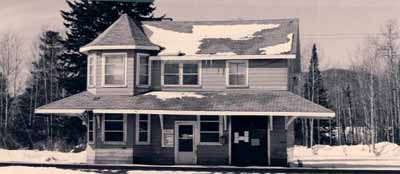Algoma Central Railway Station
Heritage Railway Station of Canada
Searchmont, Ontario

Exterior photo
(© (M. Carter, Heritage Research Associates, 1994.))
Address :
Highway 532, Searchmont, Ontario
Recognition Statute:
Heritage Railway Stations Protection Act (R.S.C., 1985, c. 52 (4th Supp.))
Designation Date:
1996-07-06
Dates:
-
1902 to 1902
(Construction)
Research Report Number:
RS-252
Description of Historic Place
The Algoma Central Railway Station at Searchmont is a two-storey wood railway station, built in 1902. It is located in the unincorporated area of Searchmont. The formal recognition is confined to the railway station building itself.
Heritage Value
Constructed during the initial phase of development of the Algoma Central Railway (ACR), the Searchmont station represents the vital role of the ACR in the economic development and settlement of northern Ontario. The ACR was a part of a series of mining, lumbering and tourism initiatives promoted by industrialist F.H. Clergue. The railway was fundamental to Searchmont’s development; both benefited from the post-World War II development of tourism in the area.
The station retains its relationship with its site, including: the tracks; a utility shed; an outdoor privy; and the natural surroundings. The station serves as a prominent gateway to and symbol of the region.
Sources: Heritage Character Statement, Algoma Central Railway Station, Searchmont, Ontario, September 1995; Heritage Research Associates Inc., Railway Station Report 252, Algoma Central Railway Station, Searchmont, Ontario.
Character-Defining Elements
Character-defining elements of the Algoma Central Railway Station at Searchmont include: its domestic form and scale, consisting of a two-storey, rectangular block, with a polygonal operator’s bay at the northeast corner, and capped by a gabled roof with a transverse gable terminating in a tower over the projecting bay; the large platform canopy, supported on triangulated eave brackets; the polygonal operator’s bay, extending to form a two-storey tower; the arrangement of openings established by 1944 renovations; surviving original window units and exterior finishes (obscured beneath aluminum siding); the surviving original interior layout, including: the agent’s office; the subsidiary office; and parts of the waiting room; surviving original finishes and fittings, including: boarded walls; wainscoting; doors; light fixtures; and wooden benches; its use of hardwood, Searchmont’s major product, as an architectural material.